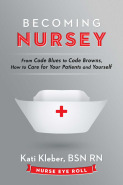Nurses are constantly working with what they’ve got (however little that may be), from subtle behavioral changes to minor complaints, to make potentially lifesaving judgment calls. That said, tuning into any one patient’s less obvious neuro changes remains a challenging and complex ask, even if your gut instinct has an impressive track record.
Below, Kati Kleber (aka Nurse Eye Roll) shares some of her own tips for observing that which often can’t really be seen in order to deliver a more accurate (and timely) neuro status assessment:
Neuro changes are tough! It’s really hard to know if someone is truly changing or if they’re just exhausted because we keep waking them up. Here are some of my neuro nurse tips.
If your patient is in the intensive care unit, intubated and sedated on propofol, and you need to complete a neuro assessment, you MUST pause the sedation for an accurate assessment. The only time that we do not pause the sedation is if we have a specific order from a physician not to do so (for example, for a patient in status with propofol infusing for seizure suppression). Otherwise, all patients need to have their sedation paused for all assessments. You cannot accurately assess someone’s neuro status (whether they’re a neuro patient or not!) with propofol infusing. It usually takes about five to 10 minutes for it to wear off to a point where you can get an accurate assessment.
I usually press pause on the propofol right when I start getting report from the night nurse, so by the time they’re done talking, I can get a good assessment done really quickly with the nurse still there and turn it back on right away.
Herniation doesn’t heal
If your patient stopped following commands, you must elicit pain to see how they respond. Neuro nurses are really good at sternal rubs, trap pinches and nail bed pressure. I know this sounds barbaric and mean, but if the patient doesn’t respond to that and they were responding before, that is a major change.
Make sure you give them enough time to respond to your painful stimuli. It can take as long as 30 seconds for it to register in their brain that they’re in pain and that they need to do something about it. Pinching a trap for one to two seconds and charting that they don’t respond to pain would be inaccurate.
I’ve gone to check out a patient for someone who was worried because the patient wasn’t waking up like they had been. So I called out their name, grabbed their hand, shook their shoulder…no response. The next step was a sternal rub. You’d be surprised how much this will wake someone up who is not changing neurologically! This will wake patients up who are annoyed with you, ignoring you, or just sleepy and not having true neuro changes. Again, I know this sounds mean, but it is essential. If they don’t respond to a sternal rub or other acceptable forms of painful stimuli, the doctor needs to know, like, STAT.
Assessment tips
- Give them credit where credit is due. When you’re scoring the Glasgow Coma Score, you need to give them credit for their best response. So if one arm localizes pain and the other has abnormal extension, they get credit for localizing.
- Don’t give pain meds or sedation unless it’s absolutely necessary. These meds will make the patient more sedated and therefore it will be more difficult to tell if they’re having neuro changes.
- Make sure you explain to the family what you’re doing before you use painful stimuli. Also, always warn the patient. My go-to line is: “Mr. Smith, you’re about to feel some pressure!” (((painful stimuli))) “I need you to come get my arm and stop me!”
- Notice spontaneous movements. Are the movements purposeful (meaning are they doing things that makes sense, like reaching for their ETT or scratching themselves) or are they just spontaneous non-purposeful movements? The physician needs to know this.
- Don’t just let them sleep all day and defer your assessment because they seem to be resting. They may not be resting; they may be obtunded. I know it sucks waking someone up all the time, but we have to do regular assessments to see if they’re changing. Always warn these patients on admission that we are going to be waking them up frequently.
- “That’s how they’ve been all day” is not an assessment. If they look the same as they did this morning when you got report from the night shift nurse, that still might not be good. Are they following commands? Are they waking up? Are their pupils reactive? Does the family think they’ve changed? Are they engaging in conversation? Etc, etc.
- Always ask direct orientation questions to patients who seem to be with it. Patients can carry on a normal conversation, but then you ask them what year it is and they reply, “Well, it’s July of 1942, of course!” Make sure you ask direct questions.
- What’s their sodium? Hyponatremia can make people super lethargic. So if it’s been 24 hours since their last BMP and their sodium was 133, they may have dropped. It’s amazing the difference a little salt can make in someone’s level of consciousness.
Talk it up
The mark of a good neuro nurse is not only solid assessment skills, but also being able to articulate it to the physician or PA. It’s really hard for them to decide what orders to put in if you call them with vague changes. Know specifically what they were doing before, what change occurred and how to communicate it to the provider.
In addition to knowing specific neuro changes, make sure you have other pieces of key information for the physician. Know when their last head CT or MRI was—what did it show? Pull up the scan, look at the stroke/tumor/mass and think about what assessment you should find with an injury in that area. If you’re calling about seizure activity, be able to articulate exactly what they did and how long it lasted.
Know the patient’s lab values (neurologists/neurosurgeons care about a patient’s sodium like cardiologists/cardiothoracic surgeons care about potassium), and any meds they have received that could have affected your neuro exam. Also, know if they’re on a steroid, mannitol or an anti-epileptic (med for seizures).
Something that’s important is to warn the patient and their family when they are admitted about what they’re in for. This also will keep you from feeling bad for waking them up—it’s part of the job! Here’s my general “welcome to no sleep” speech:
“While you’re here with us in the hospital, we’re going to wake you up frequently to make sure things in your brain are not changing. When your brain changes, it doesn’t show up on the monitor or in your vital signs, it shows up in these little tests/assessments that we do frequently, and that’s why it’s really important for us not only to do them, but for you to do the best you can with each assessment. We will be asking you to do the same things over and over again, but it’s very important to see how your brain is doing. Take advantage of the times that we’re not in here to nap and we’ll do the best we can to cluster our care to allow you time to sleep.”
When to freak out
There are some emergent neuro nurse situations. Keep in mind there are usually tons of warning signs—however, some people herniate very quickly, before anything could be done even if you knew what was going on.
- Blown pupils (4-6 mm, nonreactive) are late neuro changes.
- Vital sign changes (sudden hypertension and bradycardia) are very late as well.
- If the patient is not intubated and you’re noticing periods of apnea or worried that they’re not protecting their airway (new snoring, agonal respirations, etc), call the MD because they may need to be intubated. If you’re waiting for an SpO2 to drop before becoming worried about their respiratory status, you’re just waiting to call a code. Always make sure the patient is protecting their airway—this is a neuro issue, not a lung issue.
- If you’re just letting your sedation ride all day, waiting for pupillary changes to occur to call the doctor about neuro changes, that’s basically saying, “I’m going to wait until my patient herniates before I do anything about it.” You cannot be reactive—you must be proactive.
- When brain cells die, they die. It’s a big deal if you miss something because it’s not like you can undo that. Blood pressures can bounce back, hearts can be restarted, clots can be removed, but when brain cells are gone…they’re gone.
Pause sedation. Assess your patients. Communicate to physicians appropriately. Educate your patients.
Neuro nurses unite!
To read more, visit NurseEyeRoll.com.
Psst! Live in the Charlotte, NC area? Kati is going to be hosting a special event at the Alegria Cherokee Store (7868 Rea Rd, Suite K, Charlotte, NC 28277) on September 22 from 11am-3pm! Enjoy food, preview new scrubs, sign up for giveaways and much more. Plus, Kati will be giving away signed copies of her book, Becoming Nursey, to the first 20 customers in the store. You won’t want to miss this special event!
 Becoming Nursey: From Code Blues to Code Browns, How to Take Care of Your Patients and Yourself talks about how to realistically live as a nurse, both at home and at the bedside…with a little humor and some shenanigans along the way. Get ready: It’s about to get real, real nursey. You can get your own copy at NurseEyeRoll.com, Amazon or Goodreads (ebook).
Becoming Nursey: From Code Blues to Code Browns, How to Take Care of Your Patients and Yourself talks about how to realistically live as a nurse, both at home and at the bedside…with a little humor and some shenanigans along the way. Get ready: It’s about to get real, real nursey. You can get your own copy at NurseEyeRoll.com, Amazon or Goodreads (ebook).
Sponsored by Cherokee Uniforms


















